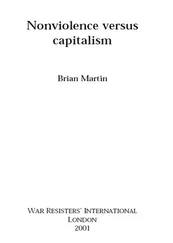(2) The effort given to different research fields would be shifted considerably. For example, particle physics would be a much lower priority whereas telecommunications and social psychology would be much higher priorities.
(3) Different particular projects in any field would be emphasised. Examples will be given in the following chapters.
(4) Research would be responsive to and involve the participation of a wide range of community interests, unlike the present situation where military interests predominate. This point will be discussed further in chapter 9.
An effective military depends heavily on effective communication, including transmission of commands, coordination of actions, transmission of information about enemy activities and about the progress of battles, among others. To serve the needs of military communication, massive investments are made into research, development and production of communication systems. For example, specially designed satellites are used to collect information about enemy installations. Massive computer systems are used to decipher foreign and domestic telecommunications. Satellites are also used to detect enemy missile launches, and special facilities are ready to transmit orders to launch nuclear attacks. Military communications are designed to be highly secure and to enable transmission of commands even when some channels have been incapacitated.
Communication is even more central to nonviolent struggle, but the type of communication most useful for nonviolent struggle is quite different than for military purposes. In the military, the role of the commanding officer is central: that person must have reliable information and be able to issue commands. This explains why there is so much attention to maintaining secure communications to the commander-in-chief in the face of attack. Extraordinary efforts — bomb shelters, special telephones, personal guards — are used to protect commanders, especially in times of crisis. Ordinary soldiers are trained to obey, not to take independent initiatives. Soldiers who disobey orders are usually subject to severe penalties; in wartime, they may be executed.
In a nonviolent struggle, participation must be voluntary: there is no way to force people to join in. Therefore, the struggle cannot have commanders in the military sense, since obedience to orders cannot be enforced. A nonviolent struggle can, however, have leaders. Noted examples include Mohandas Gandhi, Martin Luther King, Jr. and Aung San Suu Kyi. In these and other cases, leaders have influence through their example, intelligence, commitment and charisma. But it is not wise to depend too strongly on such individuals to provide guidance. Many nonviolence leaders take a front-line role, participating in civil disobedience and other confrontations with the opponent. They may be arrested, imprisoned or killed. In general, they are much more vulnerable than military commanders, who usually stay away from the fighting. Therefore, nonviolent activists must be prepared to continue the struggle effectively in the absence of their most experienced and knowledgeable members. All of this means that as many people as possible should be ready and able to analyse the situation, initiate action, make decisions and in general carry on the struggle.
For these reasons, nonviolent struggle is best served by a decentralised, interactive and cooperative system of communication, decision-making and action. [1] . Andreas Speck notes that this same list of values — decentralised, interactive, cooperative — can also be obtained by starting from the values of a just society.
This provides a very different set of priorities for science and technology than military agendas.
The following sections examine a number of communication media: television, radio, cassettes, newspapers, leaflets and the underground press, telephone and fax, the post, conversations and meetings, and computer networks. In each case, I comment on the value of the medium for nonviolent struggle and on ways in which this value might be increased. When giving case studies, I try to provide some context for the role of communication technology which, in every case, is only one component of a complex struggle in which social factors are of central importance. The chapter concludes with a general assessment of the types of communication technology most likely to be useful for nonviolent struggle, drawing on theoretical considerations as well as the case studies.
Television is an enormously powerful medium. Most people in western societies watch it for many hours each week. Furthermore, there is a great deal of trust in the image of reality presented on the TV screen, more than in newspapers for example.
There is very little opportunity for participation in the production of broadcast television. It is essentially an autocratic medium. A very few people make decisions about content, which is then transmitted to a large audience. Furthermore, the television image is quite an artificial and manipulated production. Few people are aware of the tremendous effort that goes into shaping each moment on the screen. Producing a high-quality television programme requires a lot of skill, equipment and money. This means that experienced professionals produce most programmes, especially the ones that most people prefer to watch.
For these reasons, television is ideal for rulers. They can influence popular perceptions by appointing or controlling a small number of television executives and producers. Dictatorships are only willing to allow television that is under their control. It is no surprise, then, that one of the prime targets in military coups is television stations. [2] . T. E. Finer, The Man on Horseback: The Role of the Military in Politics (London: Pall Mall Press, 1962); D. J. Goodspeed, The Conspirators: A Study in the Coup d’État (London: Macmillan, 1962); Edward Luttwak, Coup d’État: A Practical Handbook (London: Allen Lane The Penguin Press, 1968), pp. 111-116.
Precisely because it is an undemocratic medium, it is highly useful to aggressors. Hence, it is important to develop ways to subvert or disable it when a hostile takeover occurs. Many television journalists, producers and technicians are sympathetic to popular movements. If they are aware of methods for nonviolent struggle, they might well be willing to participate by hindering efforts by aggressors to control television and by enabling popular concerns to be broadcast.
Redesigning broadcast facilities and making advance preparations could aid the use (or interruption) of television in a nonviolent struggle. For example, broadcast facilities could be designed so that technicians, staff or even viewers could interrupt transmission in case of a hostile takeover. Some means would be necessary to prevent use of this facility in “normal” times, such as the need for a considerable number of people to enter codes. Broadcast facilities could be designed so that, in case of emergency, a special signal indicating a hostile takeover was transmitted along with the picture. Special tapes could be produced — dealing with methods of nonviolence, ways to undermine control of television by aggressors, etc. — and stored safely for transmission in case of emergency.
Heavy consumption of broadcast television makes a society more vulnerable to takeover. For long-term security based on nonviolent techniques, the role of television should be reduced. If most people are active transmitters rather than just receivers of messages, then there is less possibility for manipulation and central control.
Occasionally, television broadcasts inadvertently aid nonviolent struggle, as in East Germany. From 1945, East Germany was ruled by a communist dictatorship. Secret police monitored activity in all spheres of life. However, West German radio and television broadcasts were readily received throughout East Germany, giving an attractive — indeed perhaps unrealistically attractive — picture of life under capitalism. In 1961, the border with West Germany was walled off to prevent emigration.
Читать дальше












